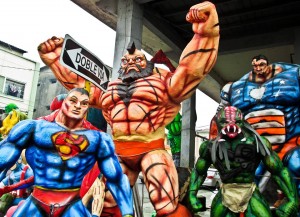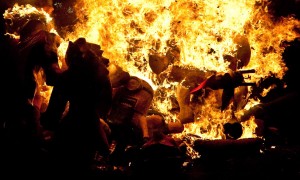The informant is a 23 year old female, originally from Salt Lake City, who recently was a Peace Corps volunteer in the city of Guayaquil in Ecuador. While in Ecuador she lived with a host family and observed and participated in many Ecuadorian customs and traditions. One tradition she was exposed to and participated in was the tradition of burning ‘monigotes’ on New Year’s Eve. She describes her experiences and this folk ritual below.
“One period of the year when there are a lot of traditions was at the close of the year, so New Year’s Eve. The tradition that I enjoyed the most was a tradition of immolating the monigotes. Monigote*, uh muñeca means doll, so monigote is a “large doll”. So they are paper-mached objects that came in a variety of forms. You could typically, especially in bigger cities, you could buy them for popular cultural figures whether that’s like famous soccer players or a lot of just recent movies from that year or famous cartoons, historical figures from like comic books or the history of the country, all just this huge variety.
“And they came in all different sizes from the size of a normal doll more or less all the way to like a story high – you would have to strap it onto the top of your car. You wouldn’t be able to fit it into your vehicle or carry it. And so everyone bought what they wanted or you also had the option of making a monigote.
“So you could make one of either – it worked both ways – it could either be someone you liked or someone you disliked or you could do it for yourself, if you wanted good luck in the New Year, if you wanted to destroy and turn into ash the memories from the past year if things had not gone well. People would often make them for their friends or people in their community. People would do them of the president.
“So this all accumulated – they would be prepared for often months in advance, starting in October or September, and some of them were incredibly detailed, the paper mache was painted elaborately, and others were more crude and some were just the heads of figures or yourself or your friends, your enemies.
“However, on the 31st of December, all of them are collected together and set into the cross-centers, the cross section of the streets in large piles and filled with fireworks. Then, as the year turned over, you would set them ablaze and they would of course explode and catch everything that wasn’t protected on fire in a kind of glorious sort of heralding in of the New Year”
*Pronounced, using IPA [mu’njegotas]
The informant noted that she was fully welcomed to participate in this festival as a foreigner. She even contributed two monigotes of her own, a minion and a giant giraffe. She also mentioned that people of every age participated in this tradition.
“Everyone was welcome into it. It brings the community together. I lived in a fairly large city and everyone, even if you weren’t close with your neighbors or with people who lived in the apartment you would all get together and it was a unifying activity.”
When discussing her interpretation of the tradition:
“I think there is a lot of symbolism in burning things, in immolating things. We use them both in the US culture and in Ecuadorian culture to symbolize celebration as well as destruction and purification. It is encompassing of many different emotions.
Analysis:
There are many elements to this custom/festival. The most obvious one, whose meaning the informant summed up pretty well, is the burning away of the past while simultaneously lighting fires of hope for the future. In the West, some of our earliest tales involving fire and burning things have they element that fire should be used to burn offerings of good will and hope. Thus, burning large dolls at a calendrically significant point is an offering of hope for the year to come.
Another interesting aspect of this tradition is its possible connection to harvest rituals, such as those documented by Mannhardt. The informant says that preparation for these dolls begins in September/October which is a common time around the world for harvest festivals and their accompanying rituals.
Another interesting element of this ritual is the significance of the the fact that the dolls are piled up in the middle of a cross roads, or cross section. Cross roads often symbolize decisions or the intersection between two significant forces. New Year’s Eve is the cross section between the old year and the new year. The association between cross roads and decisions could mean signify either that you are hoping that the burning of these dolls will bless your decisions for the coming year or it be a nod to the fact that it is not all about luck and that your decisions play a role in how the next year will turn out.
Images:

Ecuadorian Monigotes – photo by informant

Burning monigotes – photo by informant


